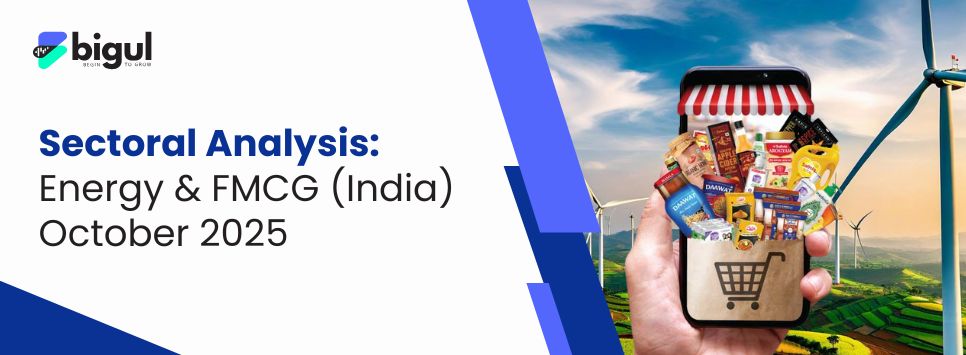Date: October 2025
1. Executive View
- Energy: The outlook remains favourable if crude oil prices indicate stability or downward pressure, especially since refining margins for diesel and aviation turbine fuel remain at reasonable levels and domestic electricity consumption shows flexibility. Refiners and oil marketing companies remain attractive in periods of rational retail pricing. Maintain core exposure to utilities and transmission, while using upstream producers selectively in crude oil upswings.
- Fast-moving consumer goods: The festival season presents attractive opportunities when palm oil and packaging resin expenses remain under control and retail channels indicate robust sell-through momentum. Maintain preference for quality leaders, adding selectively when gross margins expand and premium product mix strengthens.
2. Energy — Key Drivers and Monitoring
| S.no | Driver to track | Positive reading | Why it matters | Likely impact across sub-segments | Positioning guidance |
| 1 | Brent crude oil price | Drifting lower or stable | Lower crude oil reduces input cost and supports fuel marketing profits when retail prices are steady | Oil marketing companies: profits improve. Refiners: neutral to positive depending on product margins. Upstream producers: can soften. | Add to oil marketing companies on pullbacks; keep balanced exposure to large refiners. |
| 2 | Refining margins on diesel and aviation turbine fuel | Holding firm or rising | Strong product margins lift overall refining earnings | Refiners: direct benefit. Oil marketing companies: neutral to mildly positive. | Add to large refiners on strength; continue while margins remain healthy. |
| 3 | Retail petrol and diesel prices in India | Timely adjustments that protect per-litre marketing margin | When pump prices reflect costs, oil marketing company profits are steadier | Oil marketing companies: direct benefit. Refiners: neutral. | Increase exposure to oil marketing companies after visible protection of marketing margins. |
| 4 | Day-ahead electricity price on the Indian Energy Exchange and peak electricity demand in megawatts | Above seasonal norms | Strong power demand supports generator earnings and grid expansion | Utilities and transmission companies: steady positive trend | Accumulate large utilities and transmission operators on pullbacks. |
| 5 | Coal inventory at power stations (days of stock) | Adequate but not excessive | Ensures reliable generation and helps keep spot prices supported | Utilities: operational comfort. Spot prices: supported if inventories are moderate | Maintain core utility exposure; trim if inventories surge and spot prices fall. |
| 6 | Solar and wind auction results and grid connection updates | Sensible winning prices and clear evacuation timelines | Healthy returns and timely execution de-risk renewable developers | Renewable developers: improved confidence and valuations | Add selectively to developers with visible grid readiness and prudent bids. |
| 7 | Value of the Indian rupee against the United States dollar | Stable or stronger rupee | A stronger rupee tempers the imported crude oil bill | Oil marketing companies and refiners: incremental support | Use currency stability to size positions slightly higher in marketing and refining. |
Energy — Cause and Effect Logic (Step-by-Step)
1. Crude oil price versus pump prices: If crude oil falls while retail petrol and diesel prices do not fall as much, per-litre marketing margin expands and oil marketing company profits usually rise quickly.
2. Product margins on diesel and aviation turbine fuel: Even with stable crude oil, strong product margins can sustain total refining profit; refiners are most sensitive to this driver.
3. Electricity demand and the day-ahead power market: Higher peak electricity demand and healthy day-ahead prices on the Indian Energy Exchange support earnings for utilities and transmission companies and provide steady compounding.
4. Auctions and grid readiness for renewables: Winning solar or wind at sensible tariffs with clear grid connection timelines supports long-term cash flows; execution visibility matters as much as megawatt size.
5. Currency and policy: A stronger Indian rupee slightly reduces imported fuel cost pressure. Government actions on retail fuel prices or producer taxes can alter profits quickly, so keep position sizes modest around policy dates.
Energy — Positioning for October
1. Refiners and oil marketing companies: Establish positions during periods of soft or stable crude oil prices when credible sources confirm healthy diesel and aviation turbine fuel margins. Increase conviction following retail price adjustments that demonstrably protect marketing spreads.
2. Utilities and transmission: Maintain foundational allocation while electricity demand and day-ahead prices exhibit strength. Exploit price pullbacks rather than pursuing momentum.
3. Upstream producers: Deploy tactically during crude oil uptrends; reduce exposure as crude oil softens.
4. Renewable developers: Focus on entities with verified grid connection plans and capacity secured at economically sensible tariffs.
Energy — Risks and Safeguards
1. Crude oil jumps and retail fuel prices remain frozen: Reduce oil marketing company exposure and rotate part of the capital to upstream producers.
2. Diesel or aviation turbine fuel margins compress: Reduce refiners and wait for margins to stabilise before re-adding.
3. Day-ahead power prices fall on a surge in coal inventories: Hold only core utility positions until prices stabilise.
4. Sudden policy change on fuel prices or producer taxation: Keep position sizes modest in policy-sensitive names; employ stop-loss levels based on Average True Range and review after announcements.
| Sno. | Driver to track | Positive reading | Why it matters | Likely impact | Positioning guidance |
| 1 | Palm oil price and packaging resin prices (High-density polyethylene and polypropylene) | Range-bound or declining trajectory | Lower input costs support stronger gross margins and easier pricing decisions | Leaders can report better profit and guide confidently | Add to quality leaders on dips; add again if results confirm stronger margins. |
| 2 | Retailer and distributor feedback on festival sell-through | Healthy restocking and quick movement of premium products | Strong secondary sales lift volumes and operating leverage | Companies with strong brands and premium lines usually lead | Add ahead of or into results; take partial profits after large upward gaps. |
| 3 | Management comments on rural demand | Steady improvement | Broader volume growth reduces need for discounts | Breadth of winners increases beyond urban-heavy names | Widen exposure modestly beyond top companies when signals improve. |
| 4 | Gross margin trend and advertising intensity | Gross margin rising quarter-on-quarter while advertising remains disciplined | Confirms durable profitability rather than one-off gains | Valuation support improves for high-quality names | Hold through results; add on constructive guidance. |
| 5 | Modern trade and electronic commerce share | Rising share | Supports premium product mix and faster sell-through | Favourable for premium-skewed portfolios | Maintain bias to premium-skewed leaders. |
3. Fast-Moving Consumer Goods — Positioning for October
- Keep a core allocation to high-quality companies with strong brands, disciplined advertising, improving gross margins, and robust modern trade and electronic commerce distribution.
- Add on pullbacks if palm oil and resin indicators remain friendly and retailer feedback on festival sales is firm; scale further when results confirm gross margin expansion and stable guidance.
- Be selective with higher-risk names unless there is clear evidence of rising gross margins and healthy sell-through.
Fast-Moving Consumer Goods — Risks and Safeguards
- A sudden rise in palm oil or resin prices: Reduce exposure to the most input-sensitive names and wait for cost relief before re-adding.
- Weak rural demand leading to heavy discounting: Prefer companies with strong premium portfolios and pricing power; avoid chasing high-valuation names after soft guidance.
Stock To Watch:
1) Tata Consumer Products Ltd
2) Nestle India Ltd
3) ONGC (Oil and Natural Gas Corporation Ltd)
4) IOC (Indian Oil Corporation Ltd)
4. Conclusion
It is important to maintain a constructive bias across both sectors. Within energy, prioritise refiners and oil marketing companies during periods of stable or declining crude oil prices when diesel and aviation turbine fuel refining margins shows strength. Complement this with steady core allocations in utilities and transmission infrastructure while electricity demand and day-ahead power prices maintain supportive levels.
In fast-moving consumer goods, emphasis is on quality market leaders where palm oil and packaging resin costs remain contained and festival sell-through shows health. Approach policy-sensitive and input-sensitive positions conservatively around event dates, construct positions through staged tranches near rising moving-average support levels, trail profits through results and auction announcements, and align risk management to realised volatility using Average True Range-based controls.

.jpg)






.jpg)
.jpg)
